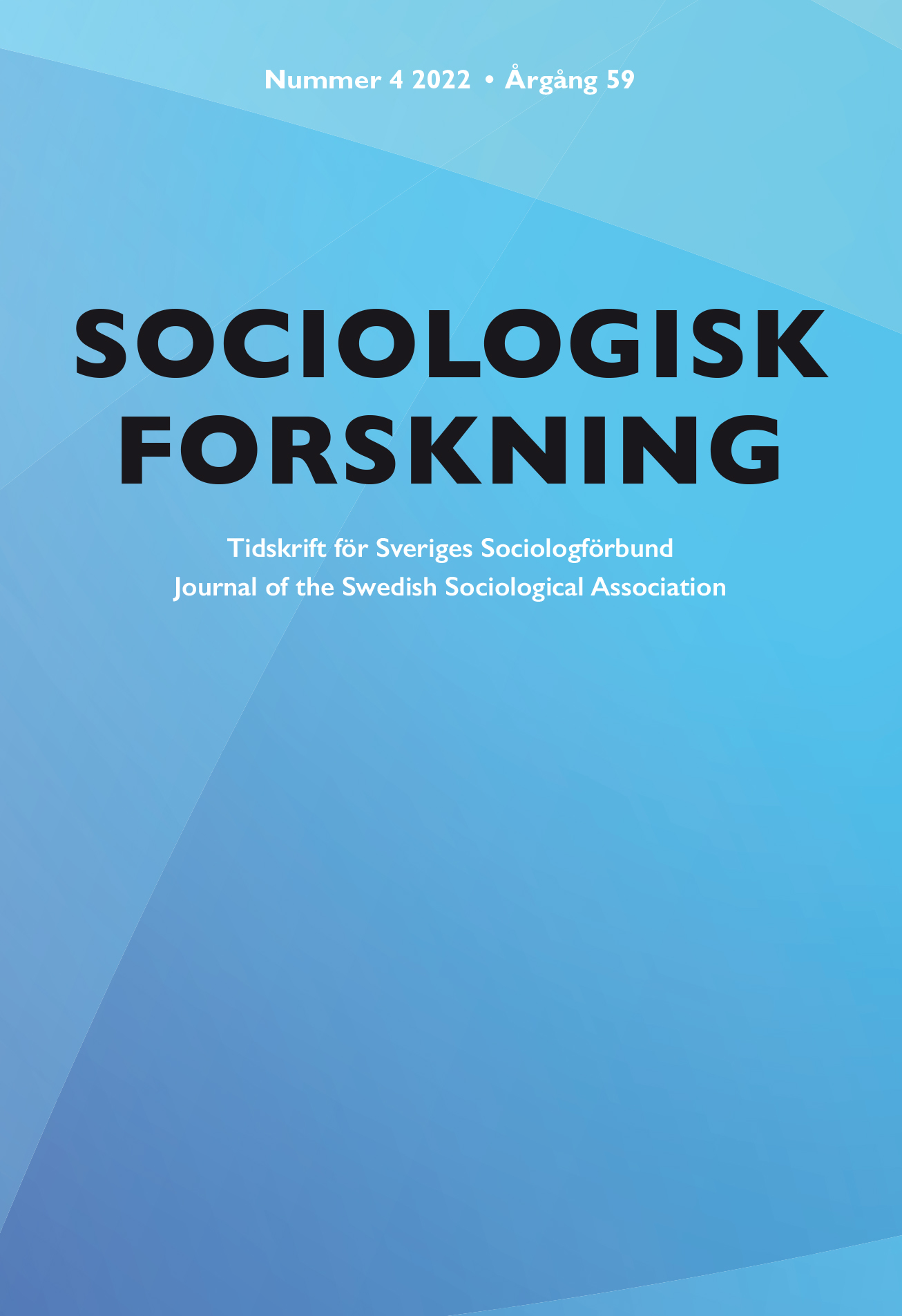Ärvd eller erövrad sekularitet?
Sekulär identitet bland postmuslimer och postkristna i Sverige
DOI:
https://doi.org/10.37062/sf.59.23768Nyckelord:
sekulär identitet, Islam, sekulära muslimer och kristna, familjebakgrund, religion, sekulariseringAbstract
Sverige är samtidigt sekulariserat och mångreligiöst. Föreliggande studie bidrar till förståelsen av denna situation genom att diskutera sekularitet bland svenskar med muslimsk respektive kristen familjebakgrund. Materialet i undersökningen kommer från en enkät som skickades till i Sverige bosatta personer födda i, eller med föräldrar som föddes i, Irak, Iran, Jugoslavien eller Turkiet, samt till en kontrollgrupp (personer med familjebakgrund i Sverige). Inledningsvis presenteras i vilken utsträckning de svarande instämmer i påståendet ”jag ser på mig själv som sekulär (icke-religiös)”. Därefter följer en explorativ regressionsanalys av vad som sammanfaller med att beskriva sig som sekulär. Analysen visar att ursprungsland och graden av sekularitet i den närmsta familjen är det som tydligast samvarierar med en sekulär självbild. Viss betydelse har också vistelsetid i landet, exponering för svensk majoritetskultur och socioekonomiska faktorer. Vår slutsats är att sekularitet bland svenskar med muslimsk familjebakgrund huvudsakligen är något de har med sig från sina anknytningsländer och inte något de förvärvar i Sverige. Detsamma gäller svenskättade svarspersoner utan migrationsbakgrund. Artikeln avslutas med en diskussion som öppnar för vidare teoretisering inom sekulariseringsfältet.
Referenser
Avramović, S. (2015) ”Understanding secularism in a post-Communist state. Case of Serbia”, 599–613 i J. Martínez-Torrón & W.C. Durham Jr. (red.) Religion and the secular state. National reports. Madrid: Servicio de Publicaciones de la Facultad de Derecho de la Universidad Complutense.
Bagg, S. & D. Voas (2009) ”The triumph of indifference. Irreligion in British society”, 91–111 i P. Zuckerman (red.) Atheism and secularity, band 2, Global expressions. New York: Praeger Press.
Baram, A. (1991) Culture, history and ideology in the formation of Bathist Iraq 1968–1989. Palgrave: London.
Berger, P.L., G. Davie & E. Fokas (2008) Religious America, secular Europe? A theme and variations. Aldershot: Ashgate. https://doi.org/10.4324/9781315244662
Berglund, J. (2013) ”Swedish religion education. Objective but marinated in Lutheran Protestantism?”, Temenos – Nordic Journal of Comparative Religion 49 (2):165–184. https://doi.org/10.33356/temenos.9545
Bruce, B. (2018) Governing Islam abroad. Turkish and Moroccan Muslims in Western Europe. Cham: Palgrave Macmillan. https://doi.org/10.1007/978-3-319-78664-3
af Burén, A. (2015) Living simultaneity. On religion among semi-secular Swedes. Huddinge: Södertörns högskola.
Calhoun, C., M. Juergensmeyer & J. VanAntwerpen (red.) (2011) Rethinking secularism. New York: Oxford University Press.
Calic, M.-J. (2018) A history of Yugoslavia. Lafayette: Purdue University Press.
Casanova, J. (2009) ”The secular and secularisms”, Social Research 76 (4):1049–1066. https://doi.org/10.1353/sor.2009.0064
Crockett, A. & D. Voas (2006) ”Generations of decline. Religious change in 20th‐century Britain”, Journal for the Scientific Study of Religion 45 (4):567–584. https://doi.org/10.1111/j.1468-5906.2006.00328.x
Dawisha, A.I. (2009) Iraq. A political history from independence to occupation. Princeton: Princeton University Press.
Enkvist, V., H. Lokrantz-Bernitz & K. Zillén (2020) Religionsfrihet. Om rättsliga skiftningar och nyanser. Uppsala: Iustus förlag.
Friberg, J.H. & E.B. Sterri (2021) ”Decline, revival, change? Religious adaptations among Muslim and non-Muslim immigrant origin youth in Norway”, International Migration Review 55 (3):718–745. https://doi.org/10.1177/0197918320986767
Frisk, E. (2020) Med känsla för religion. Sentiment och innehåll i associationer till tre religiösa identiteter. Masteruppsats. Uppsala: Sociologiska institutionen, Uppsala universitet.
Frisk, L. & P. Åkerbäck (2015) New religiosity in contemporary Sweden. The Dalarna study in national and international context. Sheffield: Equinox.
Gelman, A. (2007) ”Struggles with survey weights and regression modeling”, Statistical Science 22 (2):153–164. https://doi.org/10.1214/088342306000000691
Gorski, P.S. (2000) ”Historicizing the secularization debate. Church, state, and society in late medieval and early modern Europe, ca. 1300 to 1700”, American sociological review 65 (1):138–167. https://doi.org/10.2307/2657295
Grim, B.J. (2018) Yearbook of international religious demography 2018. New York: Brill. https://doi.org/10.1163/9789004372634
Hagevi, M. (2017) ”Religious change over the generations in an extremely secular society. The case of Sweden”, Review of Religious Research 59 (4):499–518. https://doi.org/10.1007/s13644-017-0294-5
Heelas, P. (red.) (2012) Spirituality in the modern world. Within religious tradition and beyond. London: Routledge.
Inglehart, R. (2018) ”Modernization, existential security, and cultural change”, 1–60 i M.J. Gelfand, C. Chiu & Y. Hong (red.) Handbook of advances in culture and psychology, volume 7. https://doi.org/10.1093/oso/9780190879228.003.0001
Inglehart, R., & W.E. Baker (2000) ”Modernization, cultural change, and the persistence of traditional values”, American Sociological Review 65 (1):19–51. https://doi.org/10.2307/2657288
Jacob, K. & F. Kalter (2013) ”Intergenerational change in religious salience among immigrant families in four European countries”, International Migration 51 (3):38–56. https://doi.org/10.1111/imig.12108
Johansen, B. & R. Spielhaus (2012) ”Counting deviance. Revisiting a decade’s production of surveys among Muslims in Western Europe”, Journal of Muslims in Europe 1 (1):81–112. https://doi.org/10.1163/221179512X644060
Johnson, D.R. & R. Young (2011) ”Toward best practices in analyzing datasets with missing data. Comparisons and recommendations”, Journal of Marriage and Family 73 (5):926–945. https://doi.org/10.1111/j.1741-3737.2011.00861.x
Kalmijn, M. (1998) ”Intermarriage and homogamy. Causes, patterns, trends”, Annual Review of Sociology 24:395–421. https://doi.org/10.1146/annurev.soc.24.1.395
Kasselstrand, I. & S. Mahmoudi (2020) ”Secularization among immigrants in Scandinavia. Religiosity across generations and duration of residence”, Social Compass 67 (4):617–636. https://doi.org/10.1177/0037768620948478
Kittelmann Flensner, K. (2015) Religious education in contemporary pluralistic Sweden. Göteborg: Göteborgs universitet.
Kott, P.S. (2007) ”Clarifying some issues in the regression analysis of survey data”, Survey Research Methods 1 (1):11–18. https://doi.org/10.18148/srm/2007.v1i1.47
Kristensson Uggla, B. (2015) Katedralens hemlighet. Sekularisering och religiös övertygelse. Skellefteå: Artos.
Kühle, L., U. Schmidt, B.A. Jacobsen & P. Pettersson (2018) ”Religion and state. Complexity in change”, 81–135 i I. Furseth (red.) Religious complexity in the public sphere. Cham: Palgrave Macmillan. https://doi.org/10.1007/978-3-319-55678-9_3
Larsson, G. (2007) Muslims in the EU. Cities report. Sweden. Budapest: Open Society Institute.
Larsson, G. & Å. Sander (2016) Islam and Muslims in Sweden. Integration or fragmentation? Johanneshov: MTM.
Lee, L. (2015) Recognizing the non-religious. Reimagining the secular. Oxford: Oxford University Press. https://doi.org/10.1093/acprof:oso/9780198736844.001.0001
Lundmark, E. (2019) ”This is the face of an atheist”. Performing private truths in precarious publics. Uppsala: Uppsala universitet.
Lövheim, M. (2004) Intersecting identities. Young people, religion, and interaction on the Internet. Uppsala: Uppsala universitet.
Migrationsverket (2021) ”Historik”, https://www.migrationsverket.se/Om-Migrationsverket/Migration-till-Sverige/Historik.html (hämtningsdatum 19 oktober 2021).
Mottahedeh, R. (2009) The mantle of the prophet. London: Oneworld Publications.
Pew Research Center (2014) ”Religious diversity index scores per country”, http://www.pewforum.org/2014/04/04/religious-diversity-index-scores-by-country (hämtningsdatum 19 december 2021).
Schnell, T. (2015) ”Dimensions of secularity (DoS). An open inventory to measure facets of secular identities”, The International Journal for the Psychology of Religion 25 (4):272–292. https://doi.org/10.1080/10508619.2014.967541
Sevinç, K., T.J. Coleman III & R.W. Hood Jr. (2018) ”Non-belief. An Islamic perspective”, Secularism and Nonreligion 7 (5):1–12. http://doi.org/10.5334/snr.111
Shaw, M. (2013) Genocide and international relations. Changing patterns in the transitions of the late modern world. Cambridge: Cambridge University Press.
Sigurdson, O. (2009) Det postsekulära tillståndet. Religion, modernitet, politik. Göteborg: Glänta produktion.
Storm, I. & D. Voas (2012) ”The intergenerational transmission of religious service attendance”, Nordic Journal of Religion and Society 25 (2):131–150. https://doi.org/10.18261/ISSN1890-7008-2012-02-02
Taylor, C. (2011) ”Western secularity”, 31–53 i C. Calhoun, M. Juergensmeyer & J. VanAntwerpen (red.). Rethinking secularism. New York: Oxford University Press.
Thurfjell, D. (2011) ”The ambiguities of Islamism and a century of Iranian opposition”, 189–209 i G. Lindquist & D. Handelman (red.) Religion, politics, and globalization. Anthropological approaches. New York: Berghahn Books. https://doi.org/10.3167/9781845457716
Thurfjell, D. (2015) Det gudlösa folket. De postkristna svenskarna och religionen. Stockholm: Norstedts.
Thurfjell, D. & E. Willander (2021) ”Muslims by ascription. On post-Lutheran secularity and Muslim immigrants”, Numen 68 (4):307–335. https://doi.org/10.1163/15685276-12341626
Voas, D. & F. Fleischmann (2012) ”Islam moves west. Religious change in the first and second generations”, Annual Review of Sociology 38: 525–545. https://doi.org/10.1146/annurev-soc-071811-145455
Watkins, C.S. (red.) (2003) The Balkans. New York: Nova Publishers.
Willander, E. (2013) ”’Jag tror på något’. Konstruktioner av tro och tilltro”, Sociologisk Forskning 50 (2):117–138. https://doi.org/10.37062/sf.50.18374
Willander, E. (2014) What counts as religion in sociology? The problem of religiosity in sociological methodology. Uppsala: Uppsala universitet.
Willander, E. (2018) ”Mellan sekulära och religiösa förväntningar. Civilreligion på individnivå i Sverige”, Sociologisk Forskning 55 (1):53–74. https://doi.org/10.37062/sf.55.18179
Willander, E. (2019) The religious landscape of Sweden. Affinity, affiliation and diversity in the 21st century. Stockholm: Swedish Agency for Support to Faith Communities.
Willander, E. (2020) Unity, division and the religious mainstream in Sweden. Cham: Palgrave Macmillian. https://doi.org/10.1007/978-3-030-52478-4
Willander, E. (2021) ”Kvinnligt, manligt, kyrkligt. En uppföljning av Berndt Gustafssons genusforskning”, 159–180 i C. Dahlgren (red.) Religionssociologisk mångfald. Texter till minne av Berndt Gustafsson, grundare av religionssociologi i Sverige. Lund: Lunds universitet.
Wohlrab-Sahr, M. & M. Burchardt (2012) ”Multiple secularities. Toward a cultural sociology of secular modernities”, Comparative Sociology 11 (6):875–909. http://doi.org/10.1163/15691330-12341249
Öztürk, A.E. (2018) ”Transformation of the Turkish diyanet both at home and abroad. Three stages”, European Journal of Turkish Studies 27. https://doi.org/10.4000/ejts.5944
Downloads
Publicerad
Referera så här
Nummer
Sektion
Licens
Copyright (c) 2023 David Thurfjell, Erika Willander

Detta verk är licensierat under en Creative Commons Erkännande-Ickekommersiell-IngaBearbetningar 4.0 Internationell-licens.
Allt material i Sociologisk Forskning publiceras med omedelbar öppen tillgång (open access), under Creative Commons-licensen CC BY-NC-ND 4.0.
Allt innehåll i tidskriften är fritt tillgängligt utan kostnad och får för icke-kommersiella syften fritt läsas, laddas ned, kopieras, delas, skrivas ut och länkas. Innehållet får dock inte ändras. När innehållet används måste författare och källa anges. Upphovsrätten till innehållet tillhör respektive författare. Inga publiceringsavgifter tas ut.





